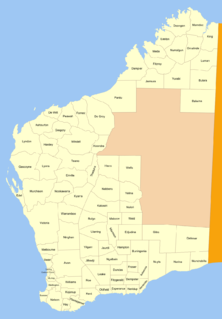
Wiluna is a small town in the Mid West region of Western Australia. It is situated on the edge of the Western Desert at the gateway to the Canning Stock Route and Gunbarrel Highway. It is the service centre of the local area for the local Martu people, the pastoral industry, the Wiluna Gold Mine, and many more people who work on other mines in the area on a "fly-in/fly-out" basis. Wiluna's climate is hot and dry, with an annual rainfall of 258 millimetres (10.2 in). Mean maximum temperatures range from 19 °C (66 °F) in July, to 38 °C (100 °F) in January.

Pearcedale is a township and coastal rural locality in Victoria, Australia, 49 km south-east of Melbourne's Central Business District, located within the City of Casey and the Shire of Mornington Peninsula local government areas. Pearcedale recorded a population of 3,867 at the 2021 census.

Murchison is a small riverside rural village located on the Goulburn River in Victoria, Australia. Murchison is located 167 kilometres from Melbourne and is just to the west of the Goulburn Valley Highway between Shepparton and Nagambie. The surrounding countryside contains orchards, vineyards and dairy farms and also HM Prison Dhurringile. At the 2016 census, Murchison had a population of 925.
Banjawarn Station is a remote cattle station in Western Australia, that previously operated as a sheep station. In the 1990s Banjawarn was owned by the Japanese doomsday cult Aum Shinrikyo, and following the Tokyo subway attack was the subject of an Australian Federal Police (AFP) investigation. Banjawarn is one of the seventy largest stations in Australia.

Mundrabilla is in a very sparsely populated area in the far south east of Western Australia. The two significant features are Mundrabilla Roadhouse and Mundrabilla Station, which are approximately 35 kilometres (22 mi) apart. At the 2016 census, Mundrabilla had a population of 23, 32% male and 68% female. The time zone in use is UTC+08:45.
Kaidun is a meteorite that fell on 3 December 1980 on a Soviet military base near what is now Al-Khuraybah in Yemen. A fireball was observed travelling from the northwest to the southeast, and a single stone weighing about 2 kilograms (4.4 lb) was recovered from a small impact pit.

Henbury Meteorites Conservation Reserve is a protected area in the Northern Territory of Australia located in the locality of Ghan.
Boolardy Station is a remote former sheep and cattle station in the Mid West (Murchison) region of Western Australia, about 194 km (121 mi) north-north-east of Pindar and 200 km (120 mi) west-south-west of Meekatharra. It is within the Shire of Murchison and situated on pastoral lease no. 3114/406. The area of the lease is 3,467.48 square kilometres (1,338.80 sq mi).
Mokoia is a small settlement in south Taranaki, in the western North Island of New Zealand. It is located on State Highway 3, 10 kilometres (6.2 mi) to the east of Hāwera and about 17 km northwest of Patea.

The Allende meteorite is the largest carbonaceous chondrite ever found on Earth. The fireball was witnessed at 01:05 on February 8, 1969, falling over the Mexican state of Chihuahua. After breaking up in the atmosphere, an extensive search for pieces was conducted and over 2 tonnes (tons) of meteorite were recovered. The availability of large quantities of samples of the scientifically-important chondrite class has enabled numerous investigations by many scientists; it is often described as "the best-studied meteorite in history." The Allende meteorite has abundant, large calcium–aluminium-rich inclusions (CAI), which are among the oldest objects formed in the Solar System.

Huckitta is a pallasite meteorite recovered in 1937 from Huckitta Cattle Station in the Northern Territory of Australia.

Park Forest is an L5 chondrite meteorite that fell on 26 March 2003 in Illinois, United States.

Tenham meteorites are the fragments of a larger meteorite that fell in 1879 in a remote area of Australia near the Tenham station, South Gregory, in western Queensland. Although the fall was seen by a number of people, its exact date has not been established. Bright meteors were seen to be moving roughly from west to east. Stones were subsequently recovered from over a large area, about 20 kilometres (12 mi) long by 5 kilometres (3.1 mi) wide.

The Weston meteorite is an H4 ordinary chondrite meteorite which fell to earth above the town of Weston, Connecticut on the morning of December 14, 1807.

Edjudina Land District is a land district of Western Australia, located within the Eastern Land Division.
This is a glossary of terms used in meteoritics, the science of meteorites.

The Mundrabilla meteorite is an iron meteorite found in 1911 in Australia, one of the largest meteorites found, with a total known weight of 22 tonnes and the main mass accounting for 12.4 tonnes.
Glenormiston Station, commonly known as Glenormiston, is a pastoral lease that operates as a cattle station in Queensland, Australia.
Yardea Station is a pastoral lease in the Australian state of South Australia that operates as a sheep station, now within the Gawler Ranges National Park. Paney Station became part of Yardea Station in 1904.

Murnpeowie or Murnpeowie Station is a pastoral lease in outback South Australia. The pastoral lease once operated as a sheep station but now operates as a cattle station. The land occupying the extent of the pastoral lease was gazetted as a locality by the Government of South Australia on 26 April 2013 with the name "Murnpeowie".















